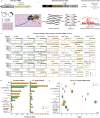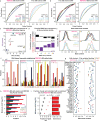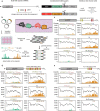Expanded palette of RNA base editors for comprehensive RBP-RNA interactome studies
- PMID: 38287010
- PMCID: PMC10825223
- DOI: 10.1038/s41467-024-45009-4
Expanded palette of RNA base editors for comprehensive RBP-RNA interactome studies
Abstract
RNA binding proteins (RBPs) are key regulators of RNA processing and cellular function. Technologies to discover RNA targets of RBPs such as TRIBE (targets of RNA binding proteins identified by editing) and STAMP (surveying targets by APOBEC1 mediated profiling) utilize fusions of RNA base-editors (rBEs) to RBPs to circumvent the limitations of immunoprecipitation (CLIP)-based methods that require enzymatic digestion and large amounts of input material. To broaden the repertoire of rBEs suitable for editing-based RBP-RNA interaction studies, we have devised experimental and computational assays in a framework called PRINTER (protein-RNA interaction-based triaging of enzymes that edit RNA) to assess over thirty A-to-I and C-to-U rBEs, allowing us to identify rBEs that expand the characterization of binding patterns for both sequence-specific and broad-binding RBPs. We also propose specific rBEs suitable for dual-RBP applications. We show that the choice between single or multiple rBEs to fuse with a given RBP or pair of RBPs hinges on the editing biases of the rBEs and the binding preferences of the RBPs themselves. We believe our study streamlines and enhances the selection of rBEs for the next generation of RBP-RNA target discovery.
© 2024. The Author(s).
Conflict of interest statement
G.W.Y. is an SAB member of Jumpcode Genomics and a co-founder, member of the Board of Directors, on the SAB, equity holder, and paid consultant for Locanabio (until 31 December 2023) and Eclipse BioInnovations. G.W.Y. is a distinguished visiting professor at the National University of Singapore. G.W.Y.’s interests have been reviewed and approved by the University of California San Diego in accordance with its conflict-of-interest policies. A.C.K. is a member of the SAB of Pairwise Plants, is an equity holder for Pairwise Plants and Beam Therapeutics, and receives royalties from Pairwise Plants, Beam Therapeutics, and Editas Medicine via patents licensed from Harvard University. A.C.K.’s interests have been reviewed and approved by the University of California San Diego in accordance with its conflict-of-interest policies. Other authors declare no competing interests.
Figures





Update of
-
Expanded palette of RNA base editors for comprehensive RBP-RNA interactome studies.bioRxiv [Preprint]. 2023 Sep 25:2023.09.25.558915. doi: 10.1101/2023.09.25.558915. bioRxiv. 2023. Update in: Nat Commun. 2024 Jan 29;15(1):875. doi: 10.1038/s41467-024-45009-4. PMID: 37808757 Free PMC article. Updated. Preprint.
References
MeSH terms
Substances
Grants and funding
- RF1 MH126719/MH/NIMH NIH HHS/United States
- K12 GM068524/GM/NIGMS NIH HHS/United States
- R35 GM138317/GM/NIGMS NIH HHS/United States
- U41 HG009889/HG/NHGRI NIH HHS/United States
- U24 HG009889/HG/NHGRI NIH HHS/United States
- T32 GM112584/GM/NIGMS NIH HHS/United States
- R01 HG004659/HG/NHGRI NIH HHS/United States
- R01 HG010646/HG/NHGRI NIH HHS/United States
- U24 HG011735/HG/NHGRI NIH HHS/United States
- R01 NS103172/NS/NINDS NIH HHS/United States
- R01 HG011864/HG/NHGRI NIH HHS/United States
- T32 CA067754/CA/NCI NIH HHS/United States
LinkOut - more resources
Full Text Sources
Molecular Biology Databases

